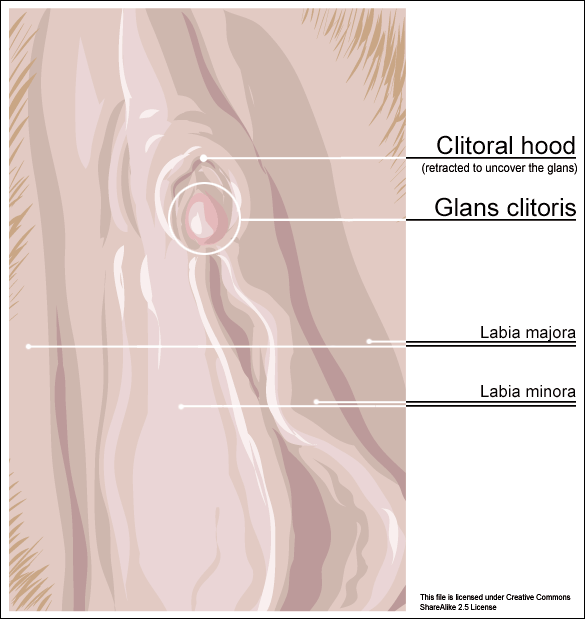Sexual arousal is caused by sexual desire during or in anticipation of sexual activity. A number of physiological changes occur in the body and mind in preparation for sex and continue during the act. For women, these changes include increased blood flow to the nipples, vulva, clitoris, and vaginal walls, and increased vaginal lubrication.
Physiological Response
The beginnings of sexual arousal in a woman's body is usually marked by vaginal lubrication, engorgement of the external genitals, and internal enlargement of the vagina. Further stimulation can lead to more vaginal wetness and further engorgement and swelling of the clitoris and the labia, along with increased redness or darkening of the skin in these areas. Changes also occur to the internal shape of the vagina and to the position of the uterus within the pelvis.

Features of the vulva
The clitoris and labial folds are labelled.
Other bodily changes include an increase in heart rate and blood pressure, as well as flushing across the chest and upper body. If sexual stimulation continues, then sexual arousal may peak into orgasm, resulting in rhythmic muscular contractions in the pelvic region characterized by an intense sensation of pleasure. Experienced by males and females, orgasms are controlled by the involuntary or autonomic nervous system.
As women age, estrogen levels decrease. Reduced estrogen levels may be associated with increased vaginal dryness and less clitoral erection when aroused, but are not directly related to other aspects of sexual interest or arousal. In older women, decreased pelvic muscle tone may prolong the time to reach orgasm, diminish the intensity of orgasms, and cause more rapid resolution. In some women, the uterine contracts that occur during orgasm may cause pain or discomfort.
Psychological Response
Mental and physical stimuli such as touch and the internal fluctuation of hormones influence sexual arousal. Cognitive factors like sexual motivation, perceived gender role expectations, and sexual attitudes play important roles in women’s self-reported levels of sexual arousal. Basson suggests that women’s need for intimacy prompts them to engage with sexual stimuli, leading to an experience of sexual desire and psychological sexual arousal.
Research by Goldey and van Anders showed that sexual cognition impacts hormone levels in women. For instance, sexual thoughts result in a rapid increase in testosterone in women who were not using hormonal contraception. Inconsistent study results indicate that, although testosterone is involved in libido and sexuality of some women, its effects can be obscured by the coexistence of psychological factors in others.